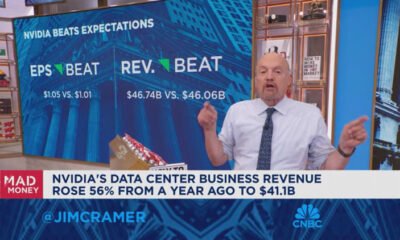Key Points
-
Form 13Fs are filed quarterly, and they allow investors to easily track which stocks Wall Street’s greatest money managers are buying and selling.
-
Appaloosa’s David Tepper has been reducing his fund’s exposure to artificial intelligence (AI) stocks — and profit-taking might not be the only catalyst.
-
However, one industry-leading AI stock (not Nvidia!) was purchased by Tepper during the March-ended quarter.
Data is the currency that keeps Wall Street running. The only problem for investors is the amount of data they have to digest can sometimes be overwhelming, which can allow something of importance to go unnoticed.
During the heart of earnings season in mid-May, institutional investors with at least $100 million in assets under management filed Form 13F with the Securities and Exchange Commission. This filing deadline, which occurred on May 15, may have slid under the radar of investors.
Where to invest $1,000 right now? Our analyst team just revealed what they believe are the 10 best stocks to buy right now. Learn More »
A 13F provides invaluable insight on which stocks Wall Street’s top-tier money managers bought and sold in the latest quarter. Though most investors tend to keep close tabs on which stocks Warren Buffett has been purchasing and selling, he’s not the only billionaire with a penchant for outperformance.
Image source: Getty Images.
For instance, Appaloosa’s David Tepper has a lengthy track record of generating outsized returns. In particular, Tepper has been a big fan tech stocks involved in the artificial intelligence (AI) revolution since late 2022.
But what you might be surprised to learn is that Tepper has been reducing his exposure to AI stocks across the board over the last year… with one exception.
Billionaire David Tepper can’t sell his fund’s AI stocks fast enough
If there’s a brand-name company that’s made artificial intelligence a foundational part of its future growth plans, there’s a pretty good chance David Tepper’s Appaloosa has been a seller of its stock over the past year (defined as April 1, 2024 – March 31, 2025).
In no particular order, Tepper has reduced or jettisoned his stakes in:
- Advanced Micro Devices: Sold all 1,630,000 shares
- Intel: Sold all 3,750,000 shares
- Oracle: Sold 1,600,000 shares (a 70% reduction)
- Microsoft(NASDAQ: MSFT): Sold 890,000 shares (a 64% reduction)
- Baidu: Sold 1,025,000 shares (a 57% reduction)
- Meta Platforms(NASDAQ: META): Sold 572,500 shares (a 51% reduction)
- Taiwan Semiconductor Manufacturing: Sold 230,000 shares (a 46% reduction)
- Amazon: Sold 1,318,000 shares (a 34% reduction)
- Alibaba: Sold 2,020,000 shares (an 18% reduction)
- Nvidia(NASDAQ: NVDA): Sold 4,120,000 shares (a 93% reduction, when adjusted for the company’s 10-for-1 stock split in June 2024)
To be fair, most of these AI stocks have skyrocketed due to strong enterprise demand for AI infrastructure, as well as pie-in-the-sky addressable market estimates. With Appaloosa’s average holding time clocking in at two years and five months, simple profit-taking may very well explain this en masse selling activity. But there’s likely more to this story than meets the eye.
For instance, every game-changing technological innovation for more than 30 years has navigated its way through an early innings bubble that eventually burst. This is a roundabout way of saying that all new innovations and technologies need ample time to mature. With most businesses not generating a positive return on their AI investment nor optimizing their AI solutions (as of yet), the table appears set for another bubble to burst.
Some of the AI stocks Tepper has exited or pared down would fare OK if the AI bubble pops. For example, Meta Platforms generates close to 98% of its net sales from advertising, which wouldn’t be demonstrably hurt if the AI bubble bursts. The same can be said for Microsoft, which still leans on its legacy segments (Windows and Office) for copious amount of cash flow, and can count on cloud infrastructure service platform Azure to sustain double-digit growth.
But this wouldn’t be the story for Wall Street’s AI darling Nvidia, which has seen almost all of its growth over the last two years originate from its AI-graphic processing units (GPUs). Nvidia has been priced as if demand for AI-GPUs won’t taper, which is highly unlikely.
Appaloosa’s billionaire chief might also have regulatory or trade/tariff concerns. Both the Joe Biden and Donald Trump administrations established export restrictions on high-powered AI chips and related equipment to China, which is a key market for companies like Nvidia.
Furthermore, the prospect of base-rate tariffs and higher “reciprocal tariff rates” instituted by President Trump threatens to eat into corporate margins, and may disrupt and/or alter supply chains and demand for U.S. hardware. It’s more worrisome news for Nvidia, which may explain why Tepper has reduced his stake in the company by 93% over the prior year.

Image source: Getty Images.
This is the one artificial intelligence stock Appaloosa’s David Tepper is buying
While selling activity in AI stocks has been almost universal for Appaloosa’s David Tepper since the start of April 2024, there is one AI company that’s been an exception: networking specialist Broadcom(NASDAQ: AVGO). During the first quarter of 2025, Appaloosa’s 13F shows Tepper opened a 130,000-share position.
Broadcom’s networking solutions are responsible for connecting tens of thousands of GPUs in AI-accelerated data centers, with the purpose of reducing tail latency and maximizing computing potential. With AI-empowered software and systems making split-second decisions, networking solutions that reduce lag/delays are imperative to the success of this technology.
For those of you who’ve put two and two together, Broadcom stock wouldn’t be immune if the AI bubble were to burst. A slowdown in data center infrastructure orders would eventually work its way down the line to Broadcom.
However (and this is a fairly important “however”), Broadcom is far more than just an AI stock, which may explain why Appaloosa’s billionaire investor has piled on.
Although demand from a small number of AI hyperscalers accounts for the bulk of Broadcom’s current growth rate, it’s a considerably more diverse business than Nvidia. It’s one of the leading providers of wireless chips used in next-generation smartphones. Further, it supplies various optical and/or networking components to the auto industry and industrial businesses. To boot, Broadcom offers enterprise cybersecurity solutions through Symantec, which it acquired in 2019. While an AI bubble would be impactful, it wouldn’t decimate Broadcom’s diverse operating segments.
Broadcom’s valuation is likely the other puzzle piece that attracted billionaire David Tepper. Though its current forward price-to-earnings (P/E) ratio of 34 isn’t exactly cheap, its forward P/E fell to the 22 to 24 range during the stock market’s swoon in March.
For the time being, Broadcom is the only true exception to Tepper’s en masse selling of AI stocks.
Should you invest $1,000 in Broadcom right now?
Before you buy stock in Broadcom, consider this:
The Motley Fool Stock Advisor analyst team just identified what they believe are the 10 best stocks for investors to buy now… and Broadcom wasn’t one of them. The 10 stocks that made the cut could produce monster returns in the coming years.
Consider whenNetflixmade this list on December 17, 2004… if you invested $1,000 at the time of our recommendation,you’d have $687,764!* Or when Nvidiamade this list on April 15, 2005… if you invested $1,000 at the time of our recommendation,you’d have $980,723!*
Now, it’s worth notingStock Advisor’s total average return is1,048% — a market-crushing outperformance compared to179%for the S&P 500. Don’t miss out on the latest top 10 list, available when you joinStock Advisor.
See the 10 stocks »
*Stock Advisor returns as of July 7, 2025
John Mackey, former CEO of Whole Foods Market, an Amazon subsidiary, is a member of The Motley Fool’s board of directors. Randi Zuckerberg, a former director of market development and spokeswoman for Facebook and sister to Meta Platforms CEO Mark Zuckerberg, is a member of The Motley Fool’s board of directors. Sean Williams has positions in Amazon, Baidu, Intel, and Meta Platforms. The Motley Fool has positions in and recommends Advanced Micro Devices, Amazon, Baidu, Intel, Meta Platforms, Microsoft, Nvidia, Oracle, and Taiwan Semiconductor Manufacturing. The Motley Fool recommends Alibaba Group and Broadcom and recommends the following options: long January 2026 $395 calls on Microsoft, short August 2025 $24 calls on Intel, and short January 2026 $405 calls on Microsoft. The Motley Fool has a disclosure policy.

![[Yonhap News]](https://aistoriz.com/wp-content/uploads/2025/09/news-p.v1.20250831.d71f26a8922c4f6da5d080fdf3ebf6ff_P1.png)
![[Yonhap News]](https://aistoriz.com/wp-content/uploads/2025/09/news-p.v1.20250831.afa375b4a1bd494088f1402e4c83be6c_P1.png)










































